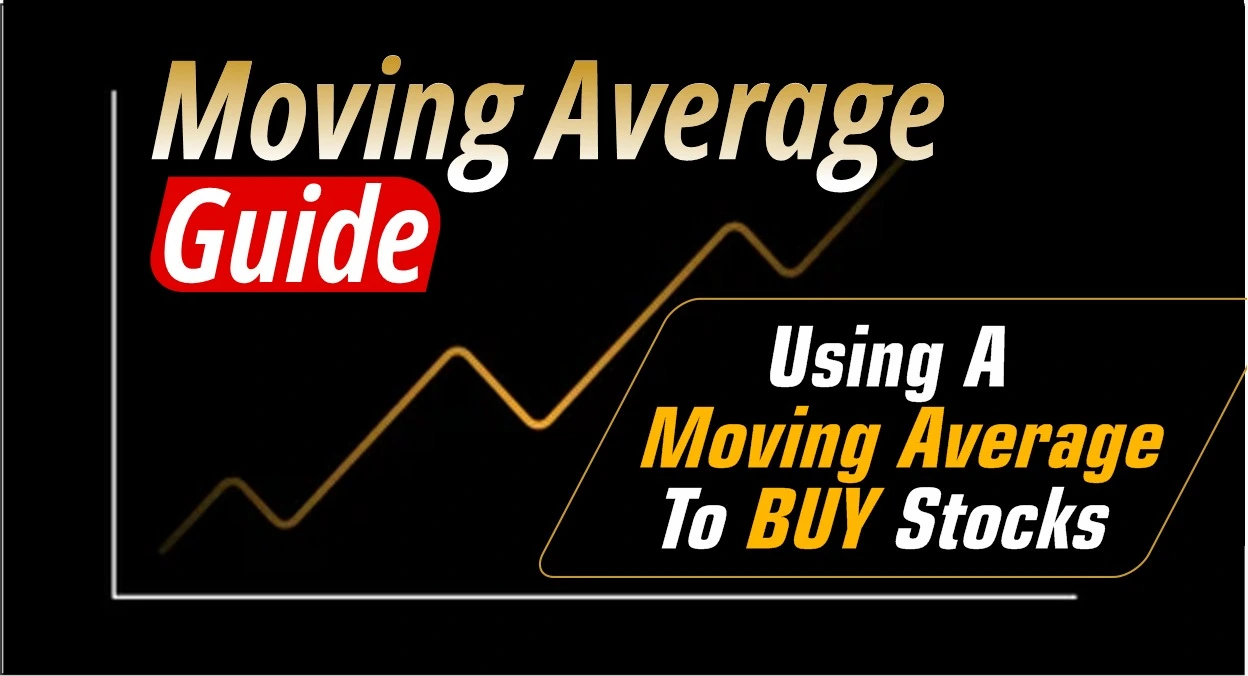In the world of stock trading, the Moving Average (MA) is one of the go-to technical tools. Traders lean on it to ease the noise of daily price swings, spot the bigger trend, and pick the best moments to buy or sell. Whether you see DMA in stock market data or a chart with Moving Average Convergence Divergence (MACD), MAs are at the heart of technical analysis.
What is a Moving Average in Stock Trading?
A Moving Average is a formula that constantly averages a stock’s price over a set number of days and updates every trading session. Rather than getting distracted by daily jumps, it highlights the overall trend.
e.g, a 50-day moving average gets recalculated every day by averaging the last 50 days of closing prices showing whether the stock is on the rise or the fall.
Moving Average Formula
SMA = (P1+P2+P3+...+Pn)/n
Where,
P = Price at each period (usually closing price)
n = Number of periods
Types of Moving Averages
1. Simple Moving Average (SMA)
Takes the average price over a chosen number of days.
Example- For a 20-day SMA, add the last 20 closing prices and divide by 20.
2. Exponential Moving Average
The Exponential Moving Average puts greater weight on the latest price action. This makes it quicker to react to price shifts compared to the simple moving average (SMA). Because of its speed, traders often trust it for quick, short-term decisions.
Moving Average Indicator
-
The Moving Average Indicator is a favorite among traders for tracking the market’s direction. They apply it to:
-
Highlight whether the market is mainly rising or falling over the long haul.
-
Pinpoint good times to enter or exit a trade.
-
Back up signals from other tools, such as the RSI or MACD. It’s a confirmation step.
DMA in the Stock Market
The term DMA, or Daily Moving Average, is widely used in charts. It calculates the average closing price of a stock over a preset number of days.
-
The 20 DMA shows short-term trends.
-
The 50 DMA often acts as a mid-range support or resistance level.
-
The 200 DMA is crucial for those focused on the long term.
-
A stock regularly closing above its 200 DMA often signals a strongly bullish picture.
Moving Average Convergence Divergence Indicator
The Moving Average Convergence Divergence (MACD) indicator measures momentum. It finds the gap between two EMAs, typically the 12-day and 26-day. This helps traders spot shifts in momentum and possible trend reversals.
-
MACD Line = 12day EMA minus 26day EMA
-
Signal Line = 9-day EMA of the MACD Line
-
Histogram = MACD Line minus the Signal Line
How to Trade With MACD
-
The MACD Line crossing above the Signal Line is known as a bullish crossover.
-
When the MACD Line falls below the Signal Line, a bearish crossover takes place.
-
A shift in the trend could be indicated if the price and MACD separate and then rejoin (divergence).
Moving Average of Moving Average
-
Some seasoned traders use the Moving Average of Moving Average technique to clean up the chart.
-
You take a moving average of a moving average (like a 10-day SMA of a 50-day SMA).
-
This method cuts down on noise during choppy weeks.
-
Long-term investors love it because it keeps the focus on the bigger trend without distractions.
How to Use Moving Averages to Buy Stocks
1. When the price is above the moving average, think buy.
-
A stock above its 50-day MA or 200-day MA is leaning bullish.
2. Golden Cross Strategy
-
When the 50-day moving average (MA) moves above the 200-day MA, a Golden Cross forms. This crossing is one of the strongest buy signals in the market.
3. Buying Pullbacks to the MA
-
During a clear uptrend, good setups happen when a stock pulls back to the 20-day or 50-day MA before it climbs again. Buying the pullback at the MA can give a strong entry point.
4. EMA for Short-Term Trading
For speed, day traders often rely on the 9-day or 21-day EMA to catch quick price moves. When the price closes above the 21-day EMA with strong volume, it typically shows the market is gaining bullish momentum. This is how the EMA trading strategy works.
Combine MAs with Other Indicators
Moving averages work best when paired with other tools. Using them with the following can give clearer signals:
- RSI (Relative Strength Index): Verifies whether a stock is overbought or oversold before entering.
- MACD: Confirms a trend change to strengthen the signal.
- Volume Analysis: Checks if a breakout has enough volume to support it.
Trend Identification
Moving averages allow you to see the big picture instead of the noisy little picture most prices create. When you trade with the average, you’re trading with the trend, not against it.
An upward slope of the line indicates that the trend is upwards. A downward slope indicates the trend is downwards. A flat line indicates that prices can’t make up their mind-they’re stuck in a sideways range. The whole point of the average is to direct you toward the direction that is most likely to continue.
Look at the chart. When the price crosses above the moving average, the average effectively becomes an invisible support zone. If the price later drops to the average, the moving line often acts as a barrier, pushing the price up, and the trend continues.
Now flip that. When the price crosses below the moving average, the average transforms into a resistance zone. If the price later attempts to rise back to the average, it often gets rejected, and the decline resumes, demonstrating that the moving average continues to serve as a useful reference line.
Limitations of Moving Averages
Lags: Since they are trailing, moving averages react after the price has moved.
Whipsaws: During sideways markets, they can give many false signals.
Always use them with other tools to improve accuracy, like RSI, MACD, and volume.
Key Takeaways
-
The Moving Average Indicator reveals which way the market is trending and where to enter or exit a trade.
-
DMA is a go-to tool for both day traders and long-term investors.
-
MACD remains one of the strongest momentum indicators when validated with other signals.
-
The Moving Average of Moving Average offers added clarity for long-term signals.
-
Pair your moving averages with momentum indicators like RSI or MACD, plus volume, to improve your trade accuracy.
Conclusion:
Moving averages are more than trailing lines - they reflect collective market psychology and guide traders toward smarter buy and sell choices. Whether you prefer DMA, EMA, or MACD, use these indicators correctly to sharpen your trading strategy and improve your results.
DISCLAIMER: This blog is NOT any buy or sell recommendation. No investment or trading advice is given. The content is purely for educational and information purposes only. Always consult your eligible financial advisor for investment-related decisions.
FAQs
1. Which moving average is best for stock trading?
For long-term investing, the 50-day and 200-day moving averages are the best choices.
For short-term trading, the 9-day and 21-day EMAs are more effective.
2. What’s the difference between DMA and EMA?
DMA stands for Simple Daily Moving Average. It takes the average price of the last X days and drops the oldest day’s price each time a new price comes in.
EMA is the Exponential Moving Average. It gives more weight to the newest price to react quickly to recent market changes.
3. Is the MACD indicator reliable?
Yes, it is, especially when you use it alongside trend direction and volume. MACD confirms price momentum and spots possible reversals, boosting your trade confidence.
4. What’s the Moving Average of Moving Average for?
It smoothes average lines further to filter out market noise. Long-term investors find it useful for spotting the bigger trend without weekend whipsaws.



